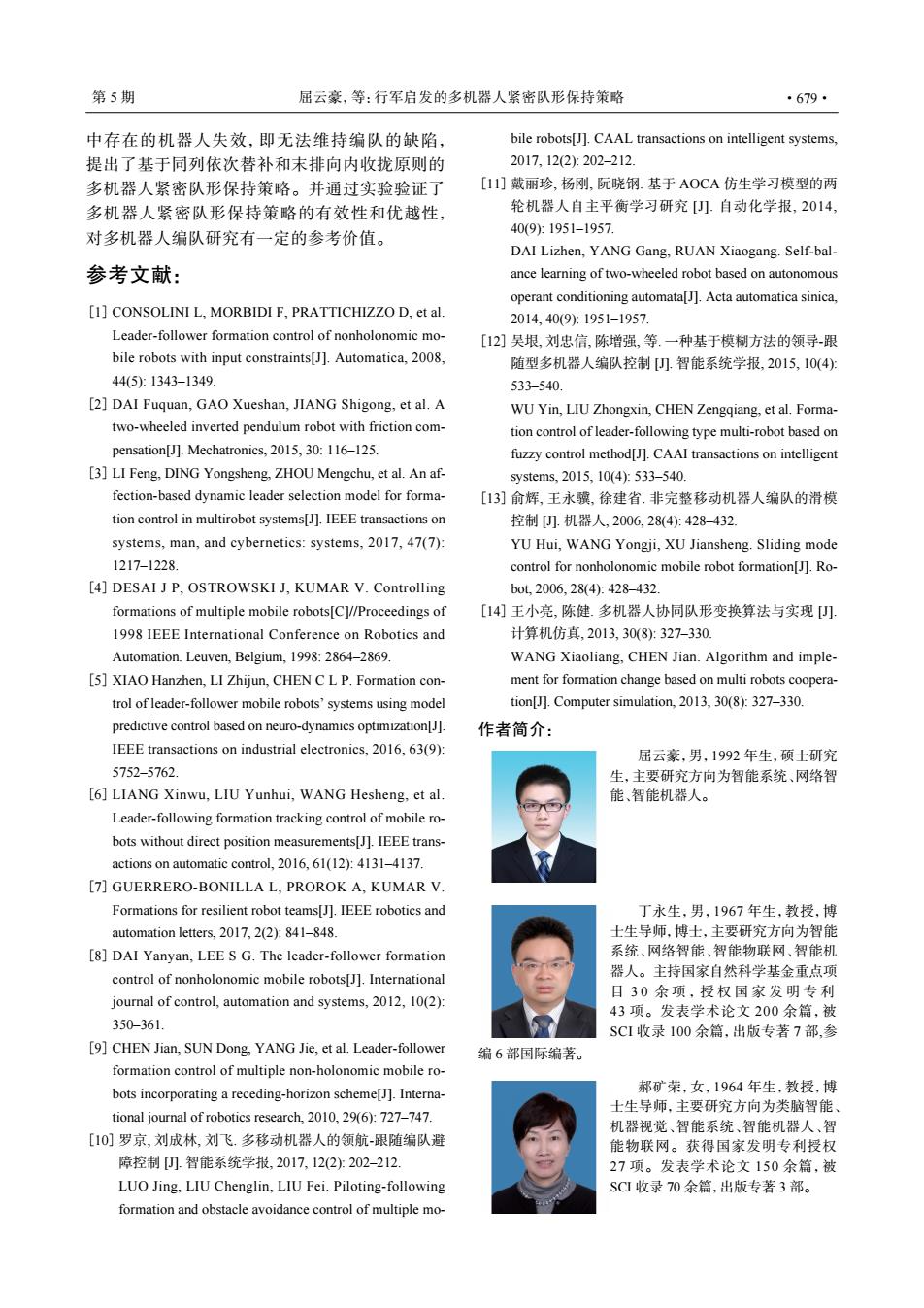正在加载图片...

第5期 屈云豪,等:行军启发的多机器人紧密队形保持策略 ·679· 中存在的机器人失效,即无法维持编队的缺陷, bile robots[J].CAAL transactions on intelligent systems, 提出了基于同列依次替补和末排向内收拢原则的 2017,12(2)202-212 多机器人紧密队形保持策略。并通过实验验证了 [11]戴丽珍,杨刚,阮晓钢.基于AOCA仿生学习模型的两 多机器人紧密队形保持策略的有效性和优越性, 轮机器人自主平衡学习研究[).自动化学报,2014, 对多机器人编队研究有一定的参考价值。 40(9:1951-1957. DAI Lizhen,YANG Gang,RUAN Xiaogang.Self-bal- 参考文献: ance learning of two-wheeled robot based on autonomous operant conditioning automata[J].Acta automatica sinica. [1]CONSOLINI L.MORBIDI F.PRATTICHIZZO D.et al. 2014.40(9:1951-1957. Leader-follower formation control of nonholonomic mo- [12]吴垠,刘忠信,陈增强,等.一种基于模糊方法的领导跟 bile robots with input constraints[J].Automatica,2008, 随型多机器人编队控制[).智能系统学报,2015,10(4) 44(5):1343-1349. 533-540. [2]DAI Fuquan,GAO Xueshan,JIANG Shigong,et al.A WU Yin,LIU Zhongxin,CHEN Zengqiang,et al.Forma- two-wheeled inverted pendulum robot with friction com- tion control of leader-following type multi-robot based on pensation[J].Mechatronics,2015,30:116-125. fuzzy control method[J].CAAI transactions on intelligent [3]LI Feng,DING Yongsheng,ZHOU Mengchu,et al.An af- systems.2015,10(4):533-540. fection-based dynamic leader selection model for forma- [13]俞辉,王永骥,徐建省.非完整移动机器人编队的滑模 tion control in multirobot systems[J].IEEE transactions on 控制[.机器人,2006,28(4):428-432 systems,man,and cybernetics:systems,2017,47(7): YU Hui,WANG Yongji,XU Jiansheng.Sliding mode 1217-1228 control for nonholonomic mobile robot formation[J.Ro- [4]DESAI J P,OSTROWSKI J,KUMAR V.Controlling bot,2006,28(4):428-432 formations of multiple mobile robots[Cl//Proceedings of [14]王小亮,陈健.多机器人协同队形变换算法与实现 1998 IEEE International Conference on Robotics and 计算机仿真,2013.30(8):327-330 Automation.Leuven,Belgium,1998:2864-2869. WANG Xiaoliang,CHEN Jian.Algorithm and imple- [5]XIAO Hanzhen,LI Zhijun,CHEN C L P.Formation con- ment for formation change based on multi robots coopera- trol of leader-follower mobile robots'systems using model tion[J].Computer simulation,2013,30(8):327-330. predictive control based on neuro-dynamics optimization[J]. 作者简介: IEEE transactions on industrial electronics,2016,63(9): 屈云豪,男,1992年生,硕士研究 5752-5762 生,主要研究方向为智能系统、网络智 [6]LIANG Xinwu,LIU Yunhui,WANG Hesheng,et al. 能、智能机器人。 Leader-following formation tracking control of mobile ro- bots without direct position measurements[J].IEEE trans- actions on automatic control,2016,61(12):4131-4137. [7]GUERRERO-BONILLA L.PROROK A.KUMAR V. Formations for resilient robot teams[J].IEEE robotics and 丁永生,男,1967年生,教授,博 automation letters,2017,2(2):841-848. 士生导师,博士,主要研究方向为智能 [8]DAI Yanyan,LEE S G.The leader-follower formation 系统、网络智能、智能物联网、智能机 器人。主持国家自然科学基金重点项 control of nonholonomic mobile robots[J.International 目30余项,授权国家发明专利 journal of control,automation and systems,2012,10(2): 43项。发表学术论文200余篇,被 350-361. SCI收录100余篇.出版专著7部,参 [9]CHEN Jian,SUN Dong,YANG Jie,et al.Leader-follower 编6部国际编著。 formation control of multiple non-holonomic mobile ro- bots incorporating a receding-horizon scheme[J].Interna- 郝矿荣,女,1964年生,教授,博 士生导师,主要研究方向为类脑智能 tional journal of robotics research,2010,29(6):727-747. 机器视觉、智能系统、智能机器人、智 [10们罗京,刘成林,刘飞.多移动机器人的领航-跟随编队避 能物联网。获得国家发明专利授权 障控制).智能系统学报,2017,12(2):202-212 27项。发表学术论文150余篇,被 LUO Jing,LIU Chenglin,LIU Fei.Piloting-following SCI收录70余篇,出版专著3部。 formation and obstacle avoidance control of multiple mo-中存在的机器人失效,即无法维持编队的缺陷, 提出了基于同列依次替补和末排向内收拢原则的 多机器人紧密队形保持策略。并通过实验验证了 多机器人紧密队形保持策略的有效性和优越性, 对多机器人编队研究有一定的参考价值。 参考文献: CONSOLINI L, MORBIDI F, PRATTICHIZZO D, et al. Leader-follower formation control of nonholonomic mobile robots with input constraints[J]. Automatica, 2008, 44(5): 1343–1349. [1] DAI Fuquan, GAO Xueshan, JIANG Shigong, et al. A two-wheeled inverted pendulum robot with friction compensation[J]. Mechatronics, 2015, 30: 116–125. [2] LI Feng, DING Yongsheng, ZHOU Mengchu, et al. An affection-based dynamic leader selection model for formation control in multirobot systems[J]. IEEE transactions on systems, man, and cybernetics: systems, 2017, 47(7): 1217–1228. [3] DESAI J P, OSTROWSKI J, KUMAR V. Controlling formations of multiple mobile robots[C]//Proceedings of 1998 IEEE International Conference on Robotics and Automation. Leuven, Belgium, 1998: 2864–2869. [4] XIAO Hanzhen, LI Zhijun, CHEN C L P. Formation control of leader-follower mobile robots’ systems using model predictive control based on neuro-dynamics optimization[J]. IEEE transactions on industrial electronics, 2016, 63(9): 5752–5762. [5] LIANG Xinwu, LIU Yunhui, WANG Hesheng, et al. Leader-following formation tracking control of mobile robots without direct position measurements[J]. IEEE transactions on automatic control, 2016, 61(12): 4131–4137. [6] GUERRERO-BONILLA L, PROROK A, KUMAR V. Formations for resilient robot teams[J]. IEEE robotics and automation letters, 2017, 2(2): 841–848. [7] DAI Yanyan, LEE S G. The leader-follower formation control of nonholonomic mobile robots[J]. International journal of control, automation and systems, 2012, 10(2): 350–361. [8] CHEN Jian, SUN Dong, YANG Jie, et al. Leader-follower formation control of multiple non-holonomic mobile robots incorporating a receding-horizon scheme[J]. International journal of robotics research, 2010, 29(6): 727–747. [9] 罗京, 刘成林, 刘飞. 多移动机器人的领航-跟随编队避 障控制 [J]. 智能系统学报, 2017, 12(2): 202–212. LUO Jing, LIU Chenglin, LIU Fei. Piloting-following formation and obstacle avoidance control of multiple mo- [10] bile robots[J]. CAAL transactions on intelligent systems, 2017, 12(2): 202–212. 戴丽珍, 杨刚, 阮晓钢. 基于 AOCA 仿生学习模型的两 轮机器人自主平衡学习研究 [J]. 自动化学报, 2014, 40(9): 1951–1957. DAI Lizhen, YANG Gang, RUAN Xiaogang. Self-balance learning of two-wheeled robot based on autonomous operant conditioning automata[J]. Acta automatica sinica, 2014, 40(9): 1951–1957. [11] 吴垠, 刘忠信, 陈增强, 等. 一种基于模糊方法的领导-跟 随型多机器人编队控制 [J]. 智能系统学报, 2015, 10(4): 533–540. WU Yin, LIU Zhongxin, CHEN Zengqiang, et al. Formation control of leader-following type multi-robot based on fuzzy control method[J]. CAAI transactions on intelligent systems, 2015, 10(4): 533–540. [12] 俞辉, 王永骥, 徐建省. 非完整移动机器人编队的滑模 控制 [J]. 机器人, 2006, 28(4): 428–432. YU Hui, WANG Yongji, XU Jiansheng. Sliding mode control for nonholonomic mobile robot formation[J]. Robot, 2006, 28(4): 428–432. [13] 王小亮, 陈健. 多机器人协同队形变换算法与实现 [J]. 计算机仿真, 2013, 30(8): 327–330. WANG Xiaoliang, CHEN Jian. Algorithm and implement for formation change based on multi robots cooperation[J]. Computer simulation, 2013, 30(8): 327–330. [14] 作者简介: 屈云豪,男,1992 年生,硕士研究 生,主要研究方向为智能系统、网络智 能、智能机器人。 丁永生,男,1967 年生,教授,博 士生导师,博士,主要研究方向为智能 系统、网络智能、智能物联网、智能机 器人。主持国家自然科学基金重点项 目 3 0 余项,授权国家发明专 利 43 项。发表学术论文 200 余篇,被 SCI 收录 100 余篇,出版专著 7 部,参 编 6 部国际编著。 郝矿荣,女,1964 年生,教授,博 士生导师,主要研究方向为类脑智能、 机器视觉、智能系统、智能机器人、智 能物联网。获得国家发明专利授权 27 项。发表学术论文 150 余篇,被 SCI 收录 70 余篇,出版专著 3 部。 第 5 期 屈云豪,等:行军启发的多机器人紧密队形保持策略 ·679·